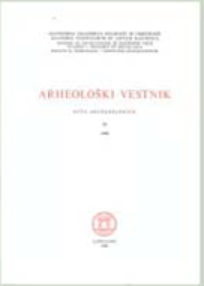A figurai fragment of a late roman monument from Celje
Abstract
Among the archaeologic materials excavated in the garden of Sadnik at Celje there was found a relief marble head, probably struck off another larger object. The head has been kept in the Town Museum at Celje. Its length is 10.5 cm, its greatest breadth passing across the root of the nose is 8.5 cm. The head had been struck off a larger relief. On the left upper part one sees a deep cut by which it had been struck off the surface. Its shape is decidedly oval. The cut of the nose is flat, the width at its root is 1.8 cm, at nostrils 2 cm. The nose cut is somewhat deeper at the root than at the nostrils. The socket of the right eye is scratched out somewhat deeper just at the root of the nose, while the outer part of the left eye socket is marked by a thicker vertical line, hardly 0.5 cm long. The mouth is not worked out. The left lower side of the face is not perfectly oval, it is somewhat flattened in. Perhaps the artist would, in this way, mark the chin, but he omitted it on the other sida There are no traces of hair, and ears are missing. The whole work shows that the stone-cutter was struggling with principles of stone cutting. All is worked out by scratching and flat cutting (Fig. 1). In Antiquity round head is the characteristic feature for the Roman art as well as for our provinces. Only with the decay of the Roman Empire round passes to oval which is the characteristic feature of the early Middle Ages. These are some instances of that period: Lenišče in Macedonia (Fig. 2): tomb-slab showing a man marching to the left. His head is nearly oval, the eyes are marked by deep imprints,the mouth Ì9 a horizontal line. There are no years, as this head is not yet decidedly oval it probably dates from late antiquity. Kavadarci in Macedonia: several reliefs, published by N. V. Vulić, belonging to the early Middle Ages. They show oval heads without hair and ears. Kavadarci: a tomb-slab of andesite (Fig. 5) showing three persons in flat relief. All heads are oval without ears, hair and moustache. The addition, various kinds of crosses, prove that it belongs to the early Middle Ages. Brodarevo: A relief (Fig. 4) showing two persons, a man and a woman. The woman wears a head-cloth, the man’s head is oval, uncovered, hairless and without ears. The head of Celje looks like male heads, I am sure it represents a man. Moreover, certain details (earless oval, flat relief etc.) permit the conclusion that it belongs to late Antiquity or early Middle-Ages. Perhaps this head was a part of some tomb, but there are no proofs of that. Possibly the head belonged to a tomb-monument composed of stone-listels which partly constitute the frame of the monument and partly shape various crosses. Such a tomb-monument is e. g. known from Moselkem in West Germany (Fig. 6). The monument might have been destroyed as well as the town of Celje by Huns (ca. 452 A. D.) or after the arrival of Slavs
Downloads
Downloads
Published
How to Cite
Issue
Section
License

This work is licensed under a Creative Commons Attribution-NonCommercial-ShareAlike 4.0 International License.
Authors guarantee that the work is their own original creation and does not infringe any statutory or common-law copyright or any proprietary right of any third party. In case of claims by third parties, authors commit their self to defend the interests of the publisher, and shall cover any potential costs.
More in: Submission chapter





